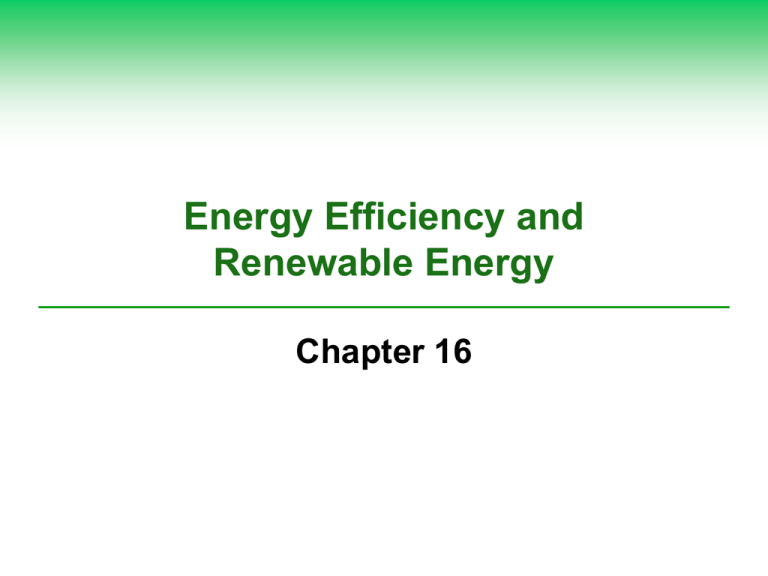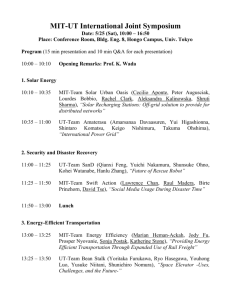We Can Convert Plants and Plant Wastes to Liquid Biofuels
advertisement

Energy Efficiency and Renewable Energy Chapter 16 16-1 Why Is Energy Efficiency an Important Energy Resource? Concept 16-1 We could save as much as 43% of all the energy we use by improving energy efficiency. We Waste Huge Amounts of Energy (2) Four widely used devices that waste energy • • • • Incandescent light bulb Motor vehicle with an internal combustion engine Nuclear power plant Coal-fired power plant Possible alternatives for the “outdated four” Net Energy Efficiency—Honest Energy Accounting Net energy efficiency • the only energy that counts Comparison of the Net Energy Efficiency for Two Types of Space Heating We Can Save Energy and Money in Industry (1) Cogeneration or combined heat and power (CHP) Replace energy-wasting electric motors Recycling materials Switch from low-efficiency incandescent lighting to higher-efficiency fluorescent and LED lighting Average Fuel Economy of New Vehicles Sold in the U.S. and Other Countries More Energy-Efficient Vehicles Are on the Way Superefficient and ultralight cars Gasoline-electric hybrid car Plug-in hybrid electric vehicle Solutions: A Hybrid-Gasoline-Electric Engine Car and a Plug-in Hybrid Car Science Focus: The Search for Better Batteries Current obstacles • Storage capacity • Overheating • Flammability In the future • • • • Lithium-ion battery Ultracapacitor Viral battery Using nanotechnology We Can Design Buildings That Save Energy and Money (1) Green architecture Living or green roofs Straw bale houses A Green or Living Roof in Chicago, IL (U.S.) We Can Save Energy and Money in Existing Buildings (2) Heat water more efficiently Use energy-efficient appliances Use energy-efficient lighting A Thermogram Showing Heat Loss Around Houses and Stores Attic • Hang reflective foil near roof to reflect heat. • Use house fan. • Be sure attic insulation is at least 30 centimeters (12 inches). Bathroom • Install water-saving toilets, faucets, and shower heads. • Repair water leaks promptly. Kitchen • Use microwave rather than stove or oven as much as possible. • Run only full loads in dishwasher and use low- or no-heat drying. • Clean refrigerator coils regularly. Basement or utility room • Use front-loading clothes washer. If possible run only full loads with warm or cold water. • Hang clothes on racks for drying. • Run only full loads in clothes dryer and use lower heat setting. • Set water heater at 140° if dishwasher is used and 120° or lower if no dishwasher is used. • Use water heater thermal blanket. • Insulate exposed hot water pipes. • Regularly clean or replace furnace filters. Outside Plant deciduous trees to block summer sun and let in winter sunlight. Other rooms • Use compact fluorescent lightbulbs or LEDs and avoid using incandescent bulbs wherever possible. • Turn off lights, computers, TV, and other electronic devices when they are not in use. • Use high efficiency windows; use insulating window covers and close them at night and on sunny, hot days. • Set thermostat as low as you can in winter and as high as you can in summer. • Weather-strip and caulk doors, windows, light fixtures, and wall sockets. • Keep heating and cooling vents free of obstructions. • Keep fireplace damper closed when not in use. • Use fans instead of, or along with, air conditioning. Fig. 16-9, p. 409 Solutions: Passive and Active Solar Heating for a Home Trade-Offs: Passive or Active Solar Heating Solutions: Woman in India Uses a Solar Cooker We Can Use Solar Cells to Produce Electricity (1) Photovoltaic (PV) cells (solar cells) • Convert solar energy to electric energy Design of solar cells Benefits of using solar cells Solar-cell power plants • Near Tucson, AZ (U.S.) • 2007: Portugal Solutions: Solar Cells Can Provide Electricity Using Solar-Cell Roof Shingles The Solar Power Industry Is Expanding Rapidly Solar cells: 0.2% of the world’s electricity 2040: could solar cells produce 16%? Nanosolar: California (U.S.) Germany: huge investment in solar cell technology General Electric: entered the solar cell market Using Wind to Produce Electricity Is an Important Step toward Sustainability (1) Wind: indirect form of solar energy • Captured by turbines • Converted into electrical energy Second fastest-growing source of energy What is the global potential for wind energy? Wind farms: on land and offshore Using Wind to Produce Electricity Is an Important Step toward Sustainability (2) “Saudi Arabia of wind power” • • • • North Dakota South Dakota Kansas Texas How much electricity is possible with wind farms in those states? Solutions: Wind Turbine and Wind Farms on Land and Offshore Producing Electricity from Wind Energy Is a Rapidly Growing Global Industry Countries with the highest total installed wind power capacity • • • • • Germany United States Spain India Denmark Installation is increasing in several other countries Wind Energy Is Booming but Still Faces Challenges Advantages of wind energy Drawbacks • • • • • Windy areas may be sparsely populated Winds die down; need back-up energy Storage of wind energy Kills migratory birds “Not in my backyard” We Can Convert Plants and Plant Wastes to Liquid Biofuels (1) Liquid biofuels • Biodiesel • Ethanol Biggest producers of biofuel • • • • Brazil The United States The European Union China We Can Convert Plants and Plant Wastes to Liquid Biofuels (3) Studies warn of problems: • Decrease biodiversity • Increase soil degrading, erosion, and nutrient leaching • Push farmers off their land • Raise food prices Case Study: Is Ethanol the Answer? (1) Ethanol converted to gasohol Brazil: “Saudi Arabia of sugarcane” • Saved $50 billion in oil import costs since the 1970s United States: ethanol from corn • Reduce the need for oil imports? • Slow global warming? • Reduce air pollution? Case Study: Is Ethanol the Answer? (2) Cellulosic ethanol: alternative to corn ethanol Sources • Switchgrass • Crop residues • Municipal wastes Advantages Disadvantages Natural Capital: Rapidly Growing Switchgrass in Kansas, U.S. 16-9 How Can We Make a Transition to a More Sustainable Energy Future? Concept 16-9 We can make a transition to a more sustainable future if we greatly improve energy efficiency, use a mix of renewable energy resources, and include environmental costs in the market prices of all energy resources. Choosing Energy Paths (2) General conclusions about possible energy paths • Gradual shift to smaller, decentralized micropower systems • Transition to a diverse mix of locally available renewable energy resources Improved energy efficiency • How? • Fossil fuels will still be used in large amounts • Why? Solutions: Decentralized Power System Solutions: Making the Transition to a More Sustainable Energy Future What Can you Do? Shifting to Sustainable Energy Use






